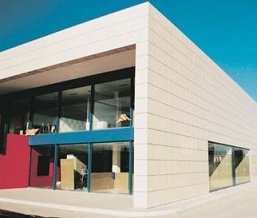La capacidad de retención de suciedad
de un material, depende no solo de
sus propiedades superficiales (textura,
porosidad, rugosidad), sino también
de las características del
producto
que
genera
la
mancha
y
del
mecanismo con que se ha producido.
La limpieza de T
AU PORCELÁNICO es
particularmente
simple,
ya
que
únicamente se requiere agua limpia y
un
detergente
de
base
alcalina.
Eventualmente podemos encontrarnos
frente a manchas de tipo doméstico
que
no
pueden
ser
totalmente
eliminadas
con
un
detergente
comercial, por lo que será necesario
el empleo de disolventes específicos
como
acetona,
aguarrás,
agua
oxigenada o lejía, señalándose en la
tabla de mantenimiento
y limpieza
cual es el producto más adecuado
para cada tipo de mancha.
Conviene recordar que, a excepción
d
e
l
á
c
i
d
o
f
l
u
o
r
h
í
d
r
i
c
o
y
s
u
s
compuestos, TAU PORCELÁNICO es
inatacable por cualquier otro producto
químico convencional.
02.4
Porcelain tile, the appropriate material for facades
Gres porcelánico, material idóneo para fachadas
TABLA DE MANTENIMIENTO Y LIMPIEZA DE TAU PORCELÁNICO
Restos de cemento cola.
Detergente con base ácida
Restos de juntas coloreadas.
Detergente con base ácida
Manchas de tipo orgánico.
Detergente con base alcalina (lejía)
Nicotina, café, Coca-cola, vino, betún, rotulador
Alcohol o Acetona
Restos
de
pintura.
Disolvente
apropiado
(Aguarras)
Restos de goma:
Disolvente apropiado (Trielina)
Suela de zapatos, golpes de maza, neumáticos.
Compuestos a base de yodo; cromo:
1º Detergente con base ácida
Betadine;
Mercromina.
2º
Agua
oxigenada
Aceites y grasas
1º Detergente con base alcalina
Amoniaco
* Lapiz: Se aconseja no utilizar el lápiz para el marcado de gres porcelánico pulido. En caso necesario probar a eliminar las rayas con una goma
de borrar blanda.
P
R
O
C
E
S
O
A
S
E
G
U
I
R
P
A
R
A
L
A
L
I
M
P
I
E
Z
A
TIPO DE MANCHA
Limpiar
inmediatamente
los
restos
de
suciedad
con
agua
y su detergente habitual, frontando suavemente con un
estropajo blando.
Manchas dificiles
Consultar con el departamento técnico
1ª ETAPA
2ª ETAPA
3ª ETAPA
Manchas
persistentes
Mantenimiento y limpieza
31
The dirt retention capacity of a material
does not
just depend on its surface
p
r
o
p
e
r
t
i
e
s
(
t
e
x
t
u
r
e
,
p
o
r
o
s
i
t
y
,
roughness),
but
also
on
the
characteristics
of the
product
that
causes soiling and on the mechanism
that produces it.
TAU PORCELAIN TILE is particularly
easy to clean, since it just requires
clean
water
and
an
alkali-based
detergent.
Stains of a domestic type may also be
encountered, however
, which cannot
be
completely
removed
with
a
commercial
detergent,
which
will
make
it necessary
to
use
specific
solvents such as acetone, turpentine
spirit, oxygenated water, or lye. The
table on maintenance and
cleaning
shows the most appropriate product
for each type of stain.
It should be borne in mind that, except
for
hydrofluoric
acid
and
its
compounds, TAU PORCELAIN
TILE
cannot
be
attacked
by
any
other
conventional
chemical
product.
TABLE FOR MAINTENANCE AND CLEANING OF TAU PORCELAIN TILE
* Pencil: It is recommended not to use pencil for marking polished porcelain tile. If necessary, try to remove the pencil marks with a soft rubber
eraser.
C
L
E
A
N
I
N
G
P
R
O
C
E
S
S
T
O
B
E
F
O
L
L
O
W
E
D
TYPE OF STAIN
Immediately clean all dirt residues with water and
your
customary
detergent,
gently
rubbing
with
a
soft
scouring pad.
Difficult stains
Consult the technical department
1
st
STEP 2
nd
STEP 3
rd
STEP
Persistent
stains
Cementitious
adhesive
residues.
Acid-based
detergent
Coloured grout residues.
Acid-based detergent
Stains
of
an
organic
nature.
Alkali-based
detergent
(bleach)
Nicotine, coffee, Coca-cola, wine, shoe polish, marker pen
Alcohol or Acetone
Paint
residues.
Appropriate
solvent
(T
urpentine)
Rubber residues:
Appropriate solvent (Trielina)
Shoe sole, rubber mallet, tyres.
CIodine-based compounds; chromium:
1
st
Acid-based detergent
Betadine; Mercurochrome
2
nd
Hydrogen peroxide
Oils and grease
1
st
Alkali-based detergent
Ammonia
Maintenance and cleaning
32
